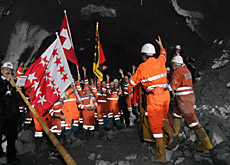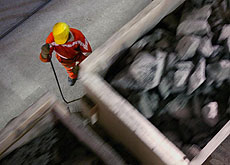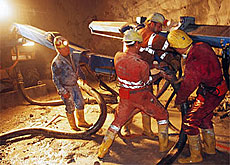Miners break through Lötschberg tunnel

Workers have blasted their way through the final metres of rock to pierce the new Lötschberg tunnel, a key component of Switzerland’s rail transit system.
Engineers needed to dynamite the final section twice, delaying a planned link up between construction workers.
More than a thousand guests, including the Swiss transport minister, Moritz Leuenberger, attended a special ceremony marking the end of tunnelling.
“With the breakthrough we have carved out the mountain for all to see,” said Leuenberger. “We are moving on.”
Work on the tunnel itself, which connects cantons Valais and Bern, began in 1999. Construction teams have been working from opposite sides, building a total of 90 kilometres of tunnels on five different worksites.
The alignment of the main tunnel had to be extremely precise. Despite coming from opposite directions, the two teams were allowed a maximum margin of error of just ten centimetres when they met up.
Construction has generated around 16 million tons of rock and dirt, 40 per cent of which has been reused.
Most of the Lötschberg project will be a dual tunnel system, although one section between Mitholz and Frutigen in canton Bern will have only one tube.
24 hours a day
Approximately 2,500 people have been working on the tunnel system, with up to 1,800 working underground in shifts 24 hours a day, seven days a week. Conditions have been difficult in the tunnel and the air has been cooled inside to 28 degrees.
The tunnelling has not been without risks. Five workers have been killed so far on the Lötschberg project and unions have called for improved safety measures and better healthcare.
The 34.6km Lötschberg tunnel, along with a similar project under the Gotthard in central Switzerland, are key to the Swiss government’s goal of moving north-south freight traffic through the Alps from road to rail.
The Lötschberg is due to open in 2007, while the 57km Gotthard base tunnel – where less than 50 per cent of the rock has been excavated – will not open before 2015.
Both projects are facing major budget overruns. The Lötschberg will now cost an estimated SFr4.2 billion ($3.5 billion), 31 per cent more than originally planned.
The new base tunnel is the successor to a much older one finished in 1913. This tunnel, built higher up in the mountain, will continue to transport cars through the Alps.
swissinfo with agencies
Planning for the new Lötschberg tunnel began in the late 1980s.
Preparatory work began in 1994, while tunnelling got underway in 1999.
When finished, the tunnel will be the world’s third-longest rail tunnel.
The first trains will use the Lötschberg in 2007.
The new tunnel is expected to cut travel time between Bern and Brig in canton Valais by a third and will shorten travel time between Germany and Milan by an hour.

In compliance with the JTI standards
More: SWI swissinfo.ch certified by the Journalism Trust Initiative


You can find an overview of ongoing debates with our journalists here. Please join us!
If you want to start a conversation about a topic raised in this article or want to report factual errors, email us at english@swissinfo.ch.